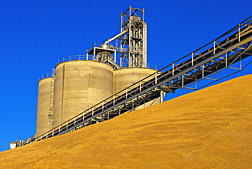This page has been archived and is being provided for reference purposes only. The page is no longer being updated, and therefore, links on the page may be invalid.
|
|
Grain Moisture Measurements May Divert Mold, Insect Infestation
By Sharon DurhamAugust 28, 2008
Grain storage bins are routinely monitored for temperature to control insect and mold problems. Now an Agricultural Research Service (ARS) scientist and his colleagues at Kansas State University (KSU) have preliminary research findings showing that monitoring carbon dioxide--along with humidity and temperature--also may help detect problems more effectively.
Grain moisture content and temperature are the primary factors affecting grain deterioration in storage. If these factors are not properly monitored and controlled, grain quality can deteriorate quickly due to mold growth and insect infestation.
ARS engineer Paul Armstrong at the agency's Grain and Marketing and Production Research Center in Manhattan, Kan., and Haidee Gonzales and Ronaldo Maghirang at KSU monitored a simulated grain storage bin during aeration to determine if high-moisture grain, or adverse storage conditions, in the bin top could be detected using sensors to measure relative humidity, temperature and carbon dioxide levels.
Relative humidity and temperature can be used to estimate grain moisture, while carbon dioxide levels indicate the amount of respiration due, primarily, to molds. Current technology allows relative humidity and temperature sensors to be placed at multiple points within the grain mass. Carbon dioxide sensing is more feasible at an aeration duct.
In the study, sensors were placed at different depths in the bin. High-moisture grain-- comprising about 11 percent of the volume--was placed at the top of the bin and produced high amounts of carbon dioxide, which in most cases was easily detectable during aeration.
Lowering grain temperature with aeration diminished the amount of carbon dioxide produced, making it more difficult to detect unless the carbon dioxide sensor was located very close to the wet grain.
Relative humidity and temperature sensing gave good estimates of grain moisture for all conditions, but under some grain conditions, high carbon dioxide levels persisted for grain considered to be at safe moisture and temperature conditions. Combining relative humidity, temperature and carbon dioxide measurements gave reasonably accurate measurements of grain moisture content as well as overall storage conditions.
ARS is the U.S. Department of Agriculture's scientific research agency.

